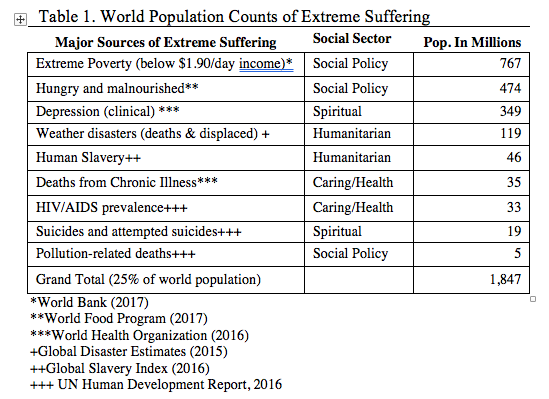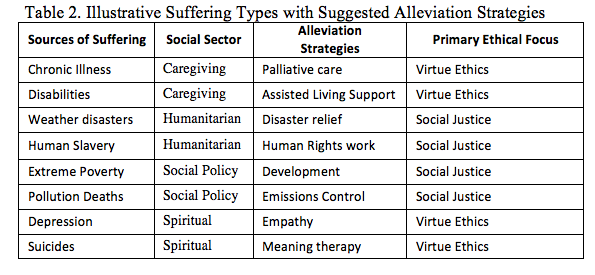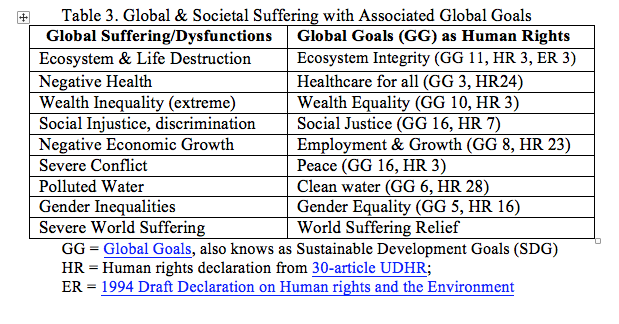
Society’s institutions to address major world suffering can be divided into four social sectors: humanitarian, social policy, informal caregiving, and the spiritual. Each social sector has suffering-alleviation strategies applicable to that social sphere. Even though estimation of the magnitude of world suffering remains rather primitive, it still reveals an enormous amount of suffering globally. The accounting of suffering also includes future suffering tied to present choices. The framework identifies various types of global suffering, each one tied to a global goal that has already been identified as a human right. Intense human suffering that violates a specific human right provides a more compelling rationale for the human right than does the traditional ‘natural rights’ argument. Human rights are legitimated by their intimate link to suffering within this framework. Relief of extreme global suffering has moral priority over enhancing the general well-being of the population. Finally, selected Global Goals define priority purposes and meaning for the planet. Suffering thus becomes the missing link between human rights and global goals.
Alleviation of suffering is the essence of human purpose, and for some it is the source of greatest meaning in their lives. Suffering is severe distress that damages one’s body, mind or interpersonal relationships and also damages one’s self-identify.
If you sit down and try to identify the major sources of extreme suffering in the world, probably this is something like what you will come up with: war and armed conflict, human slavery, refugees, racism, poverty, hunger, illness, gender violence, and other human rights violations. These implicitly refer to the present time. If we expand this to the future, they include such things as global warming.
The framework proposed here reveals the intimate, powerful link between suffering and associated human rights. Suffering that violates a specific human right legitimized the human right and the declaration of the human right makes the suffering more serious.
Global Social Sectors of Suffering-alleviation
Suffering may be felt individually but its alleviation is social and requires not only social cooperation but social institutions that work together effectively. Most suffering-alleviation that transpires collectively occurs within one of these four social sectors: the humanitarian sector, the social policy sector, the caregiving/health sector, and the spiritual sector. This pattern arises from the social institutions that have been constructed within each sector to facilitate coordinated and individual behavior to reduce suffering.
Each of the four sectors provides a unique frame with which to view the world. The types of alleviation strategies within each sector emerged from a review of the literature on social action.
The Humanitarian Sector. This sector consists of organizations committed to humanitarian action because they champion charitable causes such as disaster relief, socio-economic development, and various human rights issues. They also meet unmet needs such as food, water, and healthcare. This sector has organized itself mainly around INGOs (International Non-Governmental Organizations), but some governmental agencies play a big role as well. The United Nations is the biggest and most comprehensive institution within this sector. Here are selected strategies used within this sector to alleviate suffering: Disaster relief, Family planning, Heroic rescuing, Philanthropy, and Reconciliation programs.
The Social Policy Sector. This sector consists of government agencies and nonprofit organizations relevant to social policy, including social welfare, crime, and justice work; safety and security; education, labor, pensions, women’s health and child benefits. Alleviation strategies within this sector include: Civil society, Development, Housing, Emissions control, Food security programs, Poverty reduction, Reducing inequality and Violence reduction.
The Caregiving Sector. The caregiving/health sector encompasses both institutionalized healthcare practice (Farmer 2013) and informal caregiving, which consists of both situations of care and caring. Here are some types of alleviation actions: Altruism & compassion, Caregiver development, Family planning, Palliative care, Resilience training, and Research.
The Spiritual Sector. In the United States, and probably in most other nations, much of the writing on suffering and its alleviation has a spiritual flavor. In the USA, the literature often takes a Christian or Buddhist perspective. However, many authors and leaders in this sector attempt to avoid taking only one point of view. Here are some types of alleviation actions: Empathy, Forgiveness, Selfless courage, and Social responsibility.
Estimating the Amount of Extreme Suffering Globally
Identifying and defining these four social sectors helps to evaluate different strategies for suffering-alleviation that may overlap sector boundaries. For example, healthcare as a strategy for suffering relief can be found not only in the Caregiving/Health sector but in the Humanitarian and Social Policy sectors.
None-the-less, as can be seen in Table 1, it may be useful to clarify the principal sector that addresses any given type of extreme suffering. This table lists nine different sources of extreme suffering and gives estimate of the total people affected. The total people affected by these sources of suffering is estimated as 1.847 Billion or 25% of the world population. (These global estimates of total people suffering by source were obtained from UN and other INGOs.)
The finding that nearly 2B (billion) out of the world population of 7.5B are experiencing extreme suffering may seem like an over-estimation, but in fact, it is probably a serious under-estimation. The estimation does not include the prevalence of sexual violence. The World Health Organization (WHO) estimated in 2016 that 42% of all women in the world had experienced either violence from a sexual partner or non-partner during their lifetime. Since we do not have a way of delimiting that exposure to a recent period of time (e.g., last year), that source of suffering was left out of our estimates. There are other human rights violations such as torture and imprisonment that were left out of these estimates as well because of lack of data.
The Future Time Frame
Commitment to alleviate suffering, whether on moral grounds or otherwise, logically applies to not only the present time but to the future as well. This implicit understanding applies to future generations—which are rarely mentioned in any policy documents. As soon as we move to future tense, the scope of suffering-alleviation becomes prevention of suffering.
Avoidable Future Suffering
Commitment to alleviate suffering, whether on moral grounds or otherwise, logically applies to not only the present time but to the future as well. This implicit understanding applies to future generations—which are rarely mentioned in any policy documents. As soon as we move to future tense, the scope of suffering-alleviation becomes prevention of suffering.
An important distinction in the analysis of future suffering is whether or not the tragedy or the suffering in the future is avoidable in the present. Such analysis is needed in order to assess the risks going forward. Avoidability is not just a matter of time frame. The issue comes up any time that conditions are produced by a combination of natural systems and human actions.
Likewise, in healthcare some suffering results from incompetency and failure to prepare for contingencies. Clearly in such instances, suffering is avoidable. The moral obligation to alleviate suffering in such instances is clearly obvious.
Prevention versus Alleviation of Suffering
Any project to alleviate suffering can be grounded in one or more time frames: past, present, or future. Humanitarian relief is delivered in the present for disasters rooted in the past. International development projects build capacities and prevention mechanisms in the present that will function as resiliencies in the future.
Climate mitigation advocacy and suffering-prevention better prepare us for both the present and the future. Increasingly the present is filled with victims of chaos that had been predicted for the future. We have often failed at suffering prevention from climate-produced catastrophes such as disasters.
We need attentiveness to the present in order to anticipate future needs. Specifically, we seek to alleviate the suffering of vulnerable populations such as the poor and the disabled in order to address the injustices of existing policies and practices of relevant institutions. The poor and neglected tend to be those who suffer the most. Giving them our greatest attention at this point in history will benefit them in the future.
An undercurrent here has been that victims of climate disasters should not be viewed just as unlucky people, but as likely victims of inaction and failure to sacrifice for the well-being of present or future generations.
Role of Moral Philosophy in the Relief of Suffering
Moral philosophies specify the elements of moral decision-making. Five such moral philosophies illustrate differences in suffering-alleviation decisions based upon each approach. These moral philosophies are virtue ethics, social justice, preference utilitarianism, consequentialism, and rights-based approaches. They each represent a different perspective on moral strategies emphasizing virtues, justice, stakeholders, outcomes and human rights respectfully.
Virtue Ethics. In the virtue ethics morality framework, virtues stem from the character of the individual decision-maker. This means that judgments regarding good and evil are the product of character traits. For example, empathy and forgiveness were identified above as strategies consistent with the Spiritual Sector. The outcome of these strategies in any given decision will be determined by associated character traits or virtues. Reinforcing these virtues is possible by examining their relevance to deeply-held, personal values such as such as compassion and kind-heartedness. It should be noted that the Eudemonic approach to well-being is historically linked to virtue ethics. Eudemonic happiness is a virtue in this perspective.
Social Justice. This moral philosophy pioneered by Aristotle was re-examined and greatly elaborated in the last Century by John Rawls (1971). Social justice describes movement towards a socially just world. In this context, social justice is based on the concepts of human rights and equality, and is defined in terms of how human rights permeated peoples’ lives throughout society. In a simple form, it constitutes fairness. Institutions work together to achieve social justice in society. The expected realization is that all members of a society have basic human rights and equal access to the benefits of their society.
Preference Utilitarianism. A moral philosophy promoted by Peter Singer defines right actions as those that fulfill the interests of all stakeholders on relevant issues. For example, Singer argues that abortion is morally right if it furthers the desires of all persons affected by the choice to terminate a pregnancy. This type of thinking has been articulated extensively in Singer’s writings on effective altruism. This approach to suffering reduction also applies to suffering-alleviation challenges like “palliative care” and “resilience training.
Consequentialism. The moral philosophy of consequentialism focuses primarily on future outcomes. This approach to moral decision-making begins with the premise that actions are morally right, if and only if, the acts maximize desired outcomes, e.g., the total good minus the total bad. The approach applies to programs for “poverty reduction,” especially when the long-term results show major decline in poverty.
Rights-Based Approaches. While Rights-Based Approaches (RBA) to the moral foundations of human suffering are generally not considered philosophies, they advance our understanding of how best to frame the moral implications of different types of suffering. A Rights Based Approach has been used by Yamin (2008) to show how it clarifies the need to view health as the product of social and economic contexts rather than as a consequence of natural or biological sources. Within this approach, suffering due to health issues also arises from healthcare techniques and preconditions such as discrimination and poverty.
Summary. Different approaches to ethics can be selected to better address the types of suffering that deserve to be alleviated. Table 2 illustrates some examples to illustrate how different ethical approaches best address particular types of suffering. The table shows that suffering related to the so called “spiritual sector” and “caregiving” sectors is more likely to benefit from a virtue ethics approach. Suffering in the social policy sector is best addressed by focusing upon the outcomes of any given suffering challenge. Even though one can identify the best ethical approach for a given suffering challenge, some types of suffering benefit from two or even all three types of ethical analysis.
Human Rights and Global Goals
Karl Popper concluded that “Human suffering makes a direct moral appeal for help,” but does not call for increasing the happiness of those already doing well. From a moral perspective, well-being and suffering are not just ‘two sides of the same coin.’ Human rights are much more concerned with avoiding the terrible than with achieving the best.
The moral imperative to alleviate suffering is the heart of every serious human rights policy. Together the human rights statement and the identification of suffering define Global Goals (GG) and give them status as moral imperatives. This does not mean that suffering-alleviation is the only goal or function of human rights.
Human rights are primarily focused on preventing the worst forms of suffering like cruelty. Other violations cause less suffering, but should not be forgotten. According to Andrew Fagan, “the ethical imperative of human suffering” provides a foundation for the formulation of human rights. This is especially true for the subset of human rights referred to as ‘economic, social and cultural rights.’ But it is also true of those rights designated as ‘civil and political rights’ as well.
Roberto Andorno and Christiana Baffone build a case for human rights being the primary intersection between human dignity and human vulnerability. If a vulnerability such as racist discrimination undermines the normative value of human dignity, the victims deserve the protection against suffering that a human rights principle can offer.
Under the auspices of the United Nations and hundreds of other organizations, the Millennium Development Goals (MDG) were formulated. In 2015, these were revised under a more elaborate set of goals called the Sustainable Development Goals (SDG). Now some organizations refer to these goals as Global Goals (GG), of which there are 17.
Table 3 lists a few of these goals in the right-hand column with the other column identifying an associated state of suffering and/or dysfunction. Note that the goal statements also serve to identify a human right, which have an implicit moral purpose. For example, the first two rows of Table 3 list Ecosystem & Life Destruction and Negative Health are instances of severe suffering. The first undercuts the goal of ecosystem (including human life) integrity (GG 11), and the second violates the human right of healthcare for all (GG 3).
Meaning and the Alleviation of Suffering
The Global Goals (GG), as defined by the United Nations and its project on Sustainable Development Goals, can be associated with one or more human rights declarations. The Global Goals define a set of global purposes or meanings for global society. Likewise, these Global Goals are candidates for the goals of any society, community or individual. As the goals are candidates for the purposes of any of these entities, they help define their meaning-based purposes.
Frankl, a pioneer in the meaning of suffering, views each person’s mission as finding and following one’s own meaning in life. According to Erickson (2006) the essential meaning of suffering is that it generates a capacity for compassion and love. Thus, not only does the act of alleviating suffering go together with meaningful purpose, it brings or produces the meaning.
Mayerfeld (2005) throughout his book on suffering and moral responsibility makes a strong case for the position that suffering explicitly creates moral obligations to alleviate it. In Mayeroff’s (1971) view, caring relationships mutually imply obligations to relieve the suffering of each other.
These perspectives demonstrate how the alleviation of suffering can provide meaning and purpose for individuals as well as for communities, societies and the world. The more that Global Goals define the desired meaning and purpose for global society, the more suffering and its relief becomes the core meaning globally. The rationale for this conclusion is that any human right or global goal is relevant to global society because as a human right it becomes more pertinent to the global society to the extent that suffering associated with any given human right is intense or severe.
The first Global Goal listed in Table 3, Ecosystem Integrity, would probably be considered the goal with the most important and meaningful world purpose because it encompasses both human and planetary life. The remaining Global Goals listed in Table 3 represent meaningful purposes but they lack consensus on their relative priority. And the table lists only a small subset of the Global Goals.
The Future of Suffering and Human Rights
The above argument for human rights bequeathing prioritization to an associated type of suffering provides a foundation for a theory of suffering, which can be pursued at a later time.
One implication of this framework is that if an instance of suffering is extreme and causes severe pain, then reduction of this suffering has a higher priority than promoting the maximum wellbeing or happiness of the majority of people. Andorno and Baffone concluded that the relief of the most severe forms of suffering has moral priority over the promotion of the general well-being of the population.
Douzinas (2000) evaluated the rejection of human rights around the world and concluded that the future of human rights may be dismal. That may be true, especially for civil and political rights but social and economic rights may have a brighter future. At least this is what is suggested by Joseph (2007). Additionally, human rights are strengthened by the associated suffering produced by the rights violation.
Conclusions
At the larger institutional levels of the humanitarian and social policy sectors lie many types of suffering-alleviation activities by which societies try to neutralize the rough edges and severe pain of suffering and prevent further avoidable suffering. The most important aspect of this conclusion is that these sectors offer opportunities for individuals to be involved in setting the agendas as well as relieving the harm.
The caregiving and spiritual sectors are organized for individual participation directly in suffering-alleviation. Thus, societies offer us a huge array of options for us to be involved in suffering reduction. While any individual is free to opt out of engaging in suffering-alleviation, our analysis reveals that worldwide many different organizations, programs and individual participants take a great deal of shared responsibility for relieving our own suffering as well that of others.
Because human rights and human suffering remain so intimately intertwined, world suffering-alleviation can serve as a more compelling global goal than even poverty, inequality and hunger. The latter global goals are in a sense already integrated into the rubric of world suffering because they are known causes of suffering. Furthermore, if the suffering at hand is sufficiently severe, it has priority over the general well-being of the population.
The framework proposed here reveals the intimate, powerful link between suffering and associated human rights. Suffering that violates a specific human right legitimized the human right and the declaration of the human right makes the suffering more serious. Suffering thus becomes the missing link between human rights and global goals.
References
Anderson, R. E. (Ed.) (2017). Alleviating World Suffering: The Challenge of Negative Quality of Life. NY: Springer.
Anderson, R. E. (Ed.) (2015). World Suffering and the quality of life. NY: Springer.
Andorno, R. & Baffone, C. (2014). Human Rights and the Moral Obligation to Alleviate Suffering. Pp. 182-200 in Green, R. & Palpant, N. (eds.). Suffering and Bioethics. NYC: Oxford University Press.
Douzinas, C. (2000). The End of Human Rights: Critical Thought at the Turn of the Century. NYC: Hart Publishing.
Eriksson, K. (2006). The Suffering Human Being. Chicago: Nordic Studies Press.
Estes, R. J. (Ed.) (2007). Advancing quality of life in a turbulent world. New York: Springer.
Fagan, A. (2008). Back to Basics: Human Rights and the Suffering Imperative. Essex Human Rights Review. Vol. 5, No. 1, Pp 1-6.
Farmer, P. (2013). To repair the world. Berkeley: University of California Press.
Frankl, V. E. (2006). Man’s Search for Meaning. Boston, Beacon Press. (Originally published in 1959.)
Joseph, P. (2017). The New Human Rights Movement: Reinventing the Economy to End Oppression. Dallas, TX: BenBella Books, Inc..
Mayerfeld, J. (2005). Suffering and moral responsibility. NY: Oxford University Press.
Mayeroff, M. (1971) On Caring. New York, NY: HarperCollins.
Popper, K. (1950). The Open Society and Its Enemies. Princeton, NJ: Princeton University Press.
Rawls, J. (1971). A Theory of Justice. NYC: Oxford.
Singer, P. (2016). Ethics in the Real World: 82 Brief Essays on Things That Matter. Princeton, NJ: Princeton University Press.
Yamin, A. E. (2008). Will we take suffering seriously? Reflections on what applying a human rights framework to health means. Health and Human Rights. 10(1) pp. 45-58.




Comments